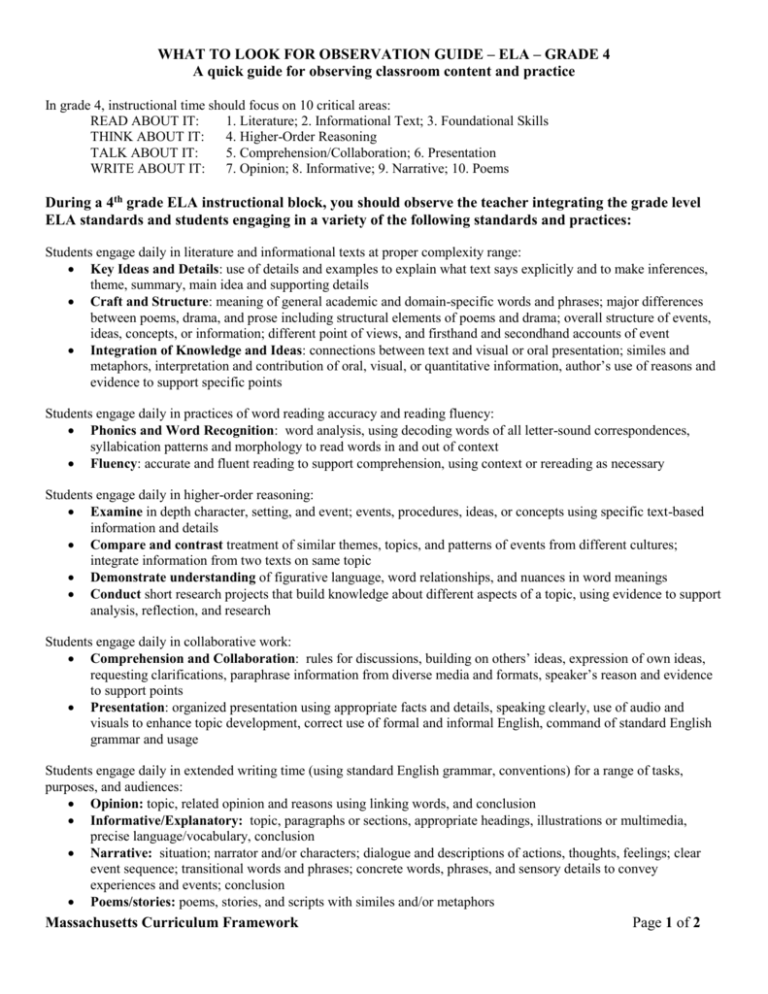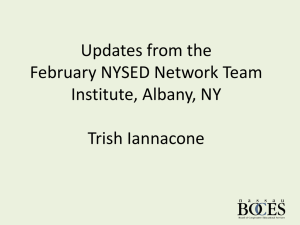What To Look For ELA Grade 4
advertisement

WHAT TO LOOK FOR OBSERVATION GUIDE – ELA – GRADE 4 A quick guide for observing classroom content and practice In grade 4, instructional time should focus on 10 critical areas: READ ABOUT IT: 1. Literature; 2. Informational Text; 3. Foundational Skills THINK ABOUT IT: 4. Higher-Order Reasoning TALK ABOUT IT: 5. Comprehension/Collaboration; 6. Presentation WRITE ABOUT IT: 7. Opinion; 8. Informative; 9. Narrative; 10. Poems During a 4th grade ELA instructional block, you should observe the teacher integrating the grade level ELA standards and students engaging in a variety of the following standards and practices: Students engage daily in literature and informational texts at proper complexity range: Key Ideas and Details: use of details and examples to explain what text says explicitly and to make inferences, theme, summary, main idea and supporting details Craft and Structure: meaning of general academic and domain-specific words and phrases; major differences between poems, drama, and prose including structural elements of poems and drama; overall structure of events, ideas, concepts, or information; different point of views, and firsthand and secondhand accounts of event Integration of Knowledge and Ideas: connections between text and visual or oral presentation; similes and metaphors, interpretation and contribution of oral, visual, or quantitative information, author’s use of reasons and evidence to support specific points Students engage daily in practices of word reading accuracy and reading fluency: Phonics and Word Recognition: word analysis, using decoding words of all letter-sound correspondences, syllabication patterns and morphology to read words in and out of context Fluency: accurate and fluent reading to support comprehension, using context or rereading as necessary Students engage daily in higher-order reasoning: Examine in depth character, setting, and event; events, procedures, ideas, or concepts using specific text-based information and details Compare and contrast treatment of similar themes, topics, and patterns of events from different cultures; integrate information from two texts on same topic Demonstrate understanding of figurative language, word relationships, and nuances in word meanings Conduct short research projects that build knowledge about different aspects of a topic, using evidence to support analysis, reflection, and research Students engage daily in collaborative work: Comprehension and Collaboration: rules for discussions, building on others’ ideas, expression of own ideas, requesting clarifications, paraphrase information from diverse media and formats, speaker’s reason and evidence to support points Presentation: organized presentation using appropriate facts and details, speaking clearly, use of audio and visuals to enhance topic development, correct use of formal and informal English, command of standard English grammar and usage Students engage daily in extended writing time (using standard English grammar, conventions) for a range of tasks, purposes, and audiences: Opinion: topic, related opinion and reasons using linking words, and conclusion Informative/Explanatory: topic, paragraphs or sections, appropriate headings, illustrations or multimedia, precise language/vocabulary, conclusion Narrative: situation; narrator and/or characters; dialogue and descriptions of actions, thoughts, feelings; clear event sequence; transitional words and phrases; concrete words, phrases, and sensory details to convey experiences and events; conclusion Poems/stories: poems, stories, and scripts with similes and/or metaphors Massachusetts Curriculum Framework Page 1 of 2 WHAT TO LOOK FOR OBSERVATION GUIDE – ELA – GRADE 4 ELA What to Look For Guide The practices below, which fall under Standards I and II of the MA Model Teacher Rubric, should be evident in planning and instruction. Any particular lesson will demonstrate some of the practices, not all. For each lesson, artifacts or observables might include: lesson plan, tasks and assessments, teacher instruction, student discussion and behavior, or student work. Student Practices Teacher Practices Standards-based Learning Standards-based Instruction Read and comprehend complex texts (or excerpts) from a variety of text structures. Use newly learned vocabulary when speaking. Apply grade level phonics/word analysis skills when reading. Engage in meaningful writing that is aligned with grade level standards. Ownership of Learning Question, contribute, and collaborate throughout the lesson. Ask clarifying and open-ended questions of their teacher(s) and peers to examine their thinking and develop a deeper understanding of content. Demonstrate ability to independently sustain interaction in order to complete tasks (e.g., during whole group, small group, centers, etc.). Communicate standards (objectives) in a clear, explicit way. Communicate and support language objectives for English Language Learners (ELLs) in a clear, explicit way. Teach standards in context and integrate the standards throughout the day. Explicitly connect previously taught objectives to current lesson. Provide mentor texts, exemplars, and rubrics. Research-based Instruction Provide multiple authentic opportunities for students to practice new skills and vocabulary. Provide explicit and systematic instruction, modeling, checking for understanding, and independent practice, with immediate and corrective feedback. Use of Data to Inform Instruction Differentiate materials, instruction, objectives, and/or content—based on student needs, data, ELL status, IEPs, etc.—to support students in meeting/exceeding grade-level curriculum expectations. Group students based on data and adjust grouping as needed. NOTES: See the full set of Standards and Indicators in ESE’s Model Teacher Rubric (http://www.doe.mass.edu/edeval/model/PartIII_AppxC.pdf). Massachusetts Curriculum Framework Page 2 of 2











